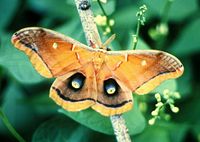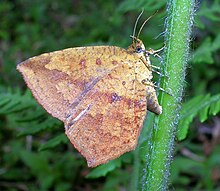| Revision as of 02:48, 21 October 2007 editRodsan18 (talk | contribs)9,774 edits →See also: tl:Pagkakaiba sa pagitan ng mga paru-paru at mga gamu-gamo← Previous edit | Revision as of 02:50, 21 October 2007 edit undoRodsan18 (talk | contribs)9,774 edits →See also: tl:Pagkakaiba sa pagitan ng mga paru-paro at mga gamu-gamoNext edit → | ||
| Line 35: | Line 35: | ||
| * ] | * ] | ||
| * ] | * ] | ||
| ] | ] | ||
| ] | ] | ||
Revision as of 02:50, 21 October 2007
A common classification of the Lepidoptera involves their differentiation into butterflies and moths. Butterflies are a natural monophyletic group, often given the sub-order Rhopalocera, which includes Papilionoidea (true butterfiles), Hesperiidae (skippers), and Hedylidae (butterfly moths). In this taxonomic scheme moths belong to the sub-order Heterocera. Other taxonomic schemes have been proposed; the most common putting the butterflies into the sub-order Ditrysia and then the "super-family" Papilionoidea, and ignoring a classification for moths. None of the taxonomic schemes is perfect however, and taxonomists commonly argue over how to define the obvious differences between butterflies and moths.
Morphological differences

Shape and structure of antennae
The most obvious difference is in the feelers, or antennae. Most butterflies have thin slender filamentous antennae which are club shaped at the end. Moths, on the other hand, often have comb-like or feathery antennae, or filamentous and unclubbed. This distinction is the basis for the earliest taxonomic divisions in the Lepidoptera - the Rhopalocera ("clubbed horn", the butterflies) and the Heterocera ("varied horn", the moths).
There are, however, exceptions to this rule and a few moths (the family Castniidae) have clubbed antennae. Some butterflies, like Pseudopontia paradoxa from the forests of central Africa, lack the clubbed ends. The Hesperiids often have an angle to the tip of the antenna.
Wing coupling mechanisms
Many moths have a frenulum which is a filament arising from the hindwing and coupling with barbs on the forewing. The frenulum can be observed only when a specimen is in hand. Some moths have a lobe on the forewing called a jugum that helps in coupling with the hindwing. Butterflies however lack these structures.
Pupae
Most moth caterpillars spin a cocoon made of silk within which they metamorphose into the pupal stage. Most butterflies on the other hand form an exposed pupa which is also termed as a chrysalis.
However there are many exceptions to this rule, for example the Hawk moths form an exposed chrysalis which however is underground. Gypsy moths sometimes form butterfly-style pupae, hanging on twigs or tree bark, although usually they create flimsy cocoons out of silk strands and a few leaves, partially exposing the chrysalis. A few Skipper butterfly larvae also make crude cocoons in which they pupate, exposing the pupa a bit. The Parnassius butterfly larvae make a flimsy cocoon for pupation and they pupate near the ground surface between debris.

Colouration of the wings
Most butterflies have bright colours on their wings. Nocturnal moths on the other hand are usually plain brown, grey, white or black and often with obscuring patterns of zigzags or swirls which help camouflage them as they rest during the day. However many day-flying moths are brightly-coloured, particularly if they are toxic. A few butterflies are also plain-colored, like the Cabbage White butterfly.
Structure of the body
Moths tend to have stout and hairy or furry-looking bodies, while butterflies have slender and smoother abdomens. Moths have larger scales on their wings which makes them look more dense and fluffy. Butterflies on the other hand possess fine scales. This difference is possibly due to the need for moths to conserve heat during the cooler nights whereas butterflies are able to absorb solar radiation.
Behavioural differences
Time of activity
Most moths are nocturnal or crepuscular while most butterflies are diurnal. There are however exceptions, including the diurnal Gypsy moth and the spectacular "Uraniidae" or Sunset moths.
Resting posture

Moths usually rest with their wings spread out to their sides. Butterflies frequently fold their wings above their backs when they are perched although they will occasionally "bask" with their wings spread for short periods. However some butterflies, like the skippers, may hold their wings either flat, or folded, or even in-between (the so-called "jet plane" position) when perched. Most moths also occasionally fold their wings above their backs when they are in a certain spot (like when there is no room to fully spread their wings). A sometimes confusing family can be the "Geometridae" (such as the Winter moth) because the adults often rest with their wings folded vertically. These moths have thin bodies and large wings like many butterflies but may be distinguished easily by structural differences in their antennae (e.g. bipectinate).